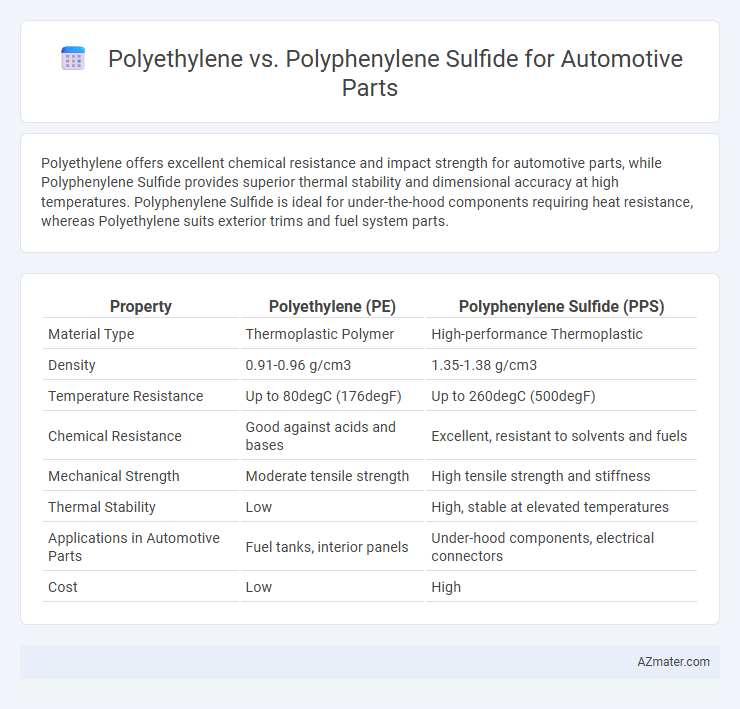Polyethylene offers excellent chemical resistance and impact strength for automotive parts, while Polyphenylene Sulfide provides superior thermal stability and dimensional accuracy at high temperatures. Polyphenylene Sulfide is ideal for under-the-hood components requiring heat resistance, whereas Polyethylene suits exterior trims and fuel system parts.
Table of Comparison
| Property | Polyethylene (PE) | Polyphenylene Sulfide (PPS) |
|---|---|---|
| Material Type | Thermoplastic Polymer | High-performance Thermoplastic |
| Density | 0.91-0.96 g/cm3 | 1.35-1.38 g/cm3 |
| Temperature Resistance | Up to 80degC (176degF) | Up to 260degC (500degF) |
| Chemical Resistance | Good against acids and bases | Excellent, resistant to solvents and fuels |
| Mechanical Strength | Moderate tensile strength | High tensile strength and stiffness |
| Thermal Stability | Low | High, stable at elevated temperatures |
| Applications in Automotive Parts | Fuel tanks, interior panels | Under-hood components, electrical connectors |
| Cost | Low | High |
Introduction to Polyethylene and Polyphenylene Sulfide
Polyethylene (PE) is a widely used thermoplastic polymer known for its excellent chemical resistance, low density, and high impact strength, making it suitable for various automotive parts such as fuel tanks and interior components. Polyphenylene Sulfide (PPS) is a high-performance engineering thermoplastic characterized by superior thermal stability, excellent dimensional stability, and resistance to harsh chemicals, often utilized in under-the-hood applications and electrical connectors. Comparing these materials involves evaluating PE's cost-effectiveness and ease of processing against PPS's advanced mechanical properties and high-temperature performance in automotive manufacturing.
Key Material Properties Comparison
Polyethylene exhibits excellent chemical resistance, low density, and impressive impact strength, making it suitable for lightweight automotive components. Polyphenylene Sulfide (PPS) offers superior thermal stability, high mechanical strength, and exceptional dimensional stability, ideal for under-the-hood parts exposed to high temperatures. Comparing their melting points, Polyethylene ranges between 115-135degC, while PPS withstands up to 280degC, highlighting PPS's advantage in demanding automotive environments.
Thermal Performance in Automotive Applications
Polyphenylene Sulfide (PPS) exhibits superior thermal performance compared to Polyethylene (PE) in automotive applications, with a continuous service temperature up to 240degC, while polyethylene typically withstands temperatures only up to 80-100degC. PPS offers excellent dimensional stability and resistance to thermal degradation under high under-the-hood temperatures, making it ideal for engine components and electrical connectors. Polyethylene's lower melting point and thermal resistance limit its use to less heat-intensive parts such as interior trims or fluid containers.
Mechanical Strength and Durability
Polyphenylene Sulfide (PPS) offers superior mechanical strength and thermal stability compared to Polyethylene (PE), making it ideal for high-stress automotive parts subjected to elevated temperatures and chemical exposure. PPS exhibits excellent dimensional stability and resistance to wear, ensuring long-term durability in engine components and electrical housings. While Polyethylene provides good impact resistance and flexibility, its lower heat deflection temperature limits its use in under-the-hood applications where PPS excels.
Chemical and Corrosion Resistance
Polyphenylene Sulfide (PPS) exhibits superior chemical resistance compared to Polyethylene (PE), maintaining structural integrity when exposed to automotive fluids such as brake fluids, oils, and coolants. PPS demonstrates exceptional resistance to corrosive chemicals and high-temperature environments, making it ideal for under-the-hood automotive parts subject to harsh conditions. In contrast, Polyethylene is more susceptible to chemical degradation and corrosion, limiting its use in critical automotive applications where prolonged exposure to aggressive substances occurs.
Weight and Design Flexibility
Polyethylene offers lightweight properties ideal for automotive parts, enhancing fuel efficiency through reduced overall vehicle weight, while Polyphenylene Sulfide (PPS) provides superior design flexibility with excellent thermal stability and chemical resistance for complex, high-performance components. PPS enables intricate molding and tight tolerances essential for under-the-hood applications, whereas polyethylene excels in simpler, lightweight exterior parts due to its ease of processing. Choosing between polyethylene and PPS depends on balancing weight reduction goals with the need for design complexity and durability in automotive manufacturing.
Cost Effectiveness and Availability
Polyethylene (PE) offers cost-effective solutions for automotive parts due to its low raw material and processing expenses, making it widely available in the automotive industry. Polyphenylene Sulfide (PPS) provides superior thermal and chemical resistance, but its higher manufacturing costs and limited supply reduce its cost-effectiveness for mass production. The availability of PE in diverse grades and its recycling potential further enhance its suitability for budget-conscious automotive applications compared to the more specialized, less accessible PPS.
Processing and Manufacturing Considerations
Polyethylene (PE) offers ease of processing through injection molding and extrusion due to its low melting point and thermoplastic nature, making it suitable for high-volume automotive parts with simple geometries. In contrast, Polyphenylene Sulfide (PPS) requires higher processing temperatures around 280-320degC and precise thermal management during compression molding or injection molding to maintain its mechanical strength and chemical resistance. Manufacturing considerations for PPS include longer cycle times and specialized equipment to handle its higher viscosity and thermal stability, which are critical for producing durable, heat-resistant automotive components.
Typical Automotive Parts Using Each Polymer
Polyethylene is commonly used in automotive parts such as fuel tanks, interior trims, and wire insulation due to its excellent chemical resistance and impact toughness. Polyphenylene Sulfide (PPS) is preferred for under-the-hood components like connectors, pump housings, and sensor brackets because of its high thermal stability and dimensional accuracy. Selecting between polyethylene and PPS depends on specific automotive application requirements, including temperature resistance and mechanical strength.
Choosing the Right Material for Your Application
Polyethylene offers excellent chemical resistance and flexibility, making it suitable for automotive parts exposed to impact and low temperatures. Polyphenylene sulfide (PPS) provides superior thermal stability, dimensional accuracy, and resistance to harsh chemicals, ideal for high-performance under-the-hood components. Selecting the right material depends on the specific application requirements such as temperature range, mechanical stress, and exposure to chemicals or fuels.

Infographic: Polyethylene vs Polyphenylene Sulfide for Automotive Part
 azmater.com
azmater.com